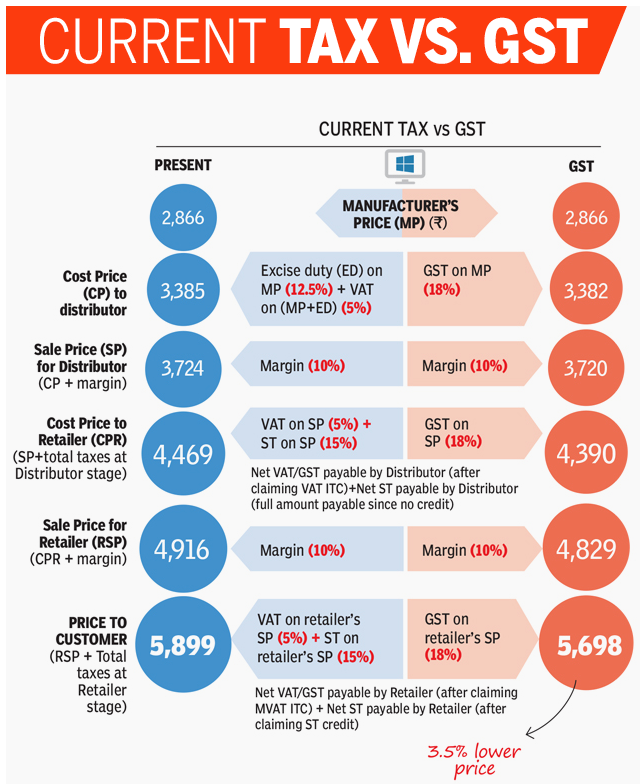India’s biggest-ever tax reform; GST is here after a long wait of almost 17 years. There is lot of anxiety in the implementation of it. GST is expected to provide a big boost to overall economic growth and revenues. As per latest World Bank report, the economy is predicted grow 7.2% in 2017-18 and 7.7% in 2019-2020 post its implementation.
But any change is never easy. Let’s look at some of the teething troubles which take its own time & shape in implementing the much-awaited unified tax system.
Challenges:
Security Vulnerabilities: In a rush to be GST ready most companies are leaving security loopholes. The cyber security team in PwC has found out security loopholes in the newly implemented IT infrastructure for GST, underscoring the risk of the recent malware that affected 300,000 computers globally. There are lots of apprehensions on the vulnerability quotient on critical financial information traversing the internet as a part of the GST process implementation.
A Halfway House: Some analysts call it as a halfway house to the final idea. There’s a scope left for arbitrariness on which item to place in what rate thereby creating a scope for lobbying to place some items in lower tax brackets making certain industry uncompetitive. “The wider impact of the classification of items under different tax slabs needs to be gauged very cautiously since under GST not only the taxes paid on goods but even the taxes paid on the services will be eligible for input tax credit,” as per Confederation of All India Traders (CAIT) body.
Mid-Year Implementation: As GST will be Implemented in the middle of the year, so businesses will have to follow the older tax structure for the first 3 months making it difficult to cross over from one tax structure to the other in such a short span resulting in ambiguity and compliance issues.
Technology Infrastructure Challenge: The system is expected to process 3.5 billion invoices every month. There are around 8 million direct taxpayers who will be required to file up to 37 tax returns in a year. In fact, GST roll out could create a “technological nightmare”.
Benefits:
Apart from the challenges, there are many benefits GST will bring to all. Let get into the broader benefits GST will bring for our country.
Common Market: India is on the verge of becoming a common market. Removing the multiplicity of taxes on the same commodity or service is about to fade away. There will be no filing of different returns with different authorities for different taxes making it a scientific system of taxation thereby reducing hidden taxes.
Pro Consumer: The consumers will have better understanding of the total incidence of tax on the product or the service they are buying. The consumer segment interest is being protected as per Finance Minister Arun Jaitley by exempting 50% of the items in retail inflation basket and overall 81% of the items will be taxed at 18% or lower rates.
All businesses, small or large, will be impacted by this new indirect tax regime. Let’s have a quick glance on its impact on these five sectors:
Automobile
Prices for SUVs and bigger cars are expected to come down.
Prices for small cars and hybrid cars will go up and cess in a range of 1% (small) and 15% (hybrid)
Telecom
18% tax rate would increase the existing burden on the industry. Cost of mobile bills will also go up.
Cost of mobile products (mobiles, laptops, etc.) will go up. But, imported mobile phones cheaper
Power
Solar projects to cost 18% more
Cost of power generation will increase by 20%
FMCG
Tax reduced for many products including Sugar, Tea, Coffee, Edible oil and will be at 5% bracket
Toothpaste, Hair oil and soaps to be taxed at 18% as compared to current 28% slab
Travel & Tourism
Hotel rooms less than ₹1,000 per night – Nil Tax. Hotel rooms for more than ₹5,000 – 28% similar to luxury category taxation
Business class travel will be costlier
Conclusion
The expected implementation of GST from 1st July 2017 is anticipated to bump the inflation initially similar to other economies when they moved to single tax regime such as Canada, Australia and New Zealand. However, it is expected to boost the growth by up to 2 percent in the long run by removing inefficiencies from the system. Lot of caution has to be maintained as the businesses will move online with GST and new IT systems need to be equipped for what the tax law needs. Apart from all the challenges being faced and only few days left, the panel of CEOs survey suggests that 88% of executives are prepared for 1st July rollout and 94% are positive about the impact on the economy.
GST & Ransomware
Amidst the ongoing ransomware euphoria that has inflicted more than 150 nations all over the world, the GSTN or the Goods and Services Tax Network that offers IT infra for GST tax regime is safe, said Prakash Kumar, CEO for GSTN. This is because the Goods and Services Tax Network does not run on the vulnerable operating system.
Post the historic decision from when it approved all the four GST bills earlier this year in April, GSTN is gearing up for handling approx. 3+ billion invoices every month under the revolutionary tax system.
Clarifying further, Mr. Kumar said to PTI, “Our network doesn’t run on Microsoft operating system and thus, we are safe from the malware. GSTN runs on Linux operating system, which is not inflicted by the ransomware threat.”
The Goods and Services Tax Network further assured its stakeholders that all the information/data will be securely stored in encrypted form and that access would be strictly limited to assessing officers and taxpayers only.
Around 60 lakh VAT, service tax and excise assessees have already enrolled onto the Goods and Services Tax Network’s portal between November 2016 to April 2017. At present, there are an estimated 80 lakh such assessees.
